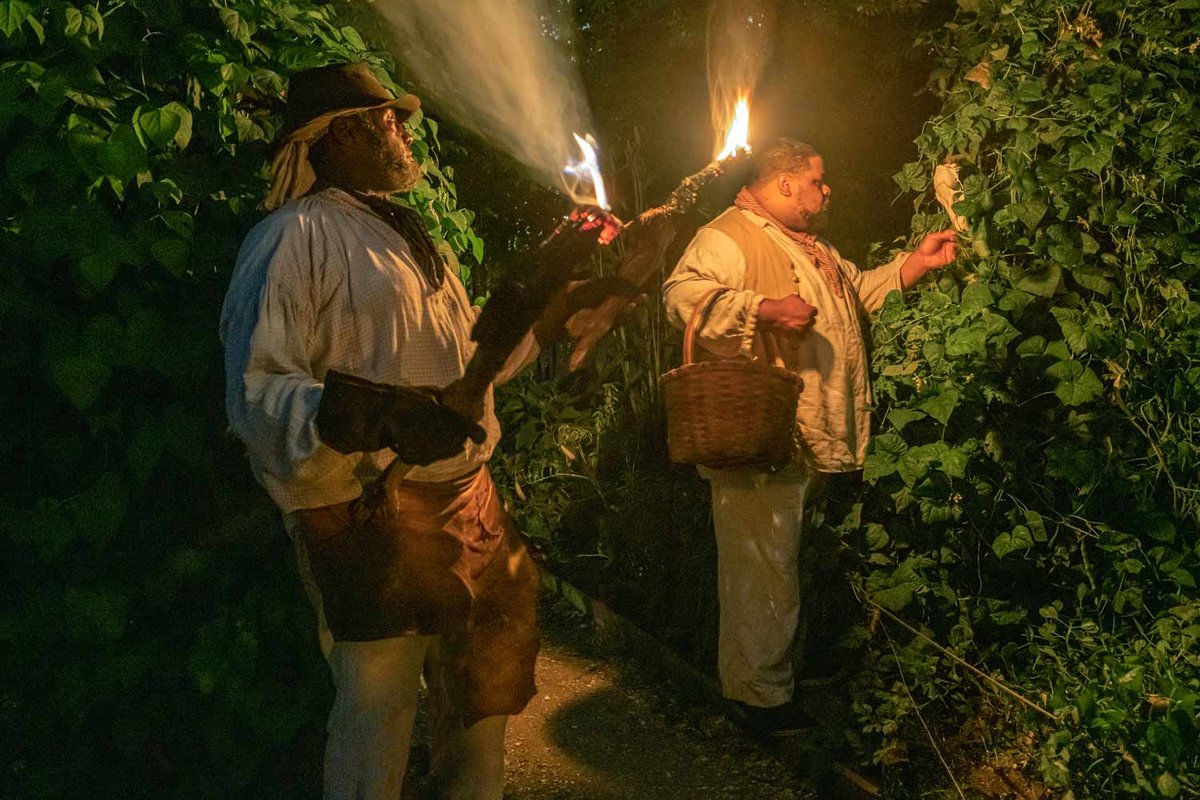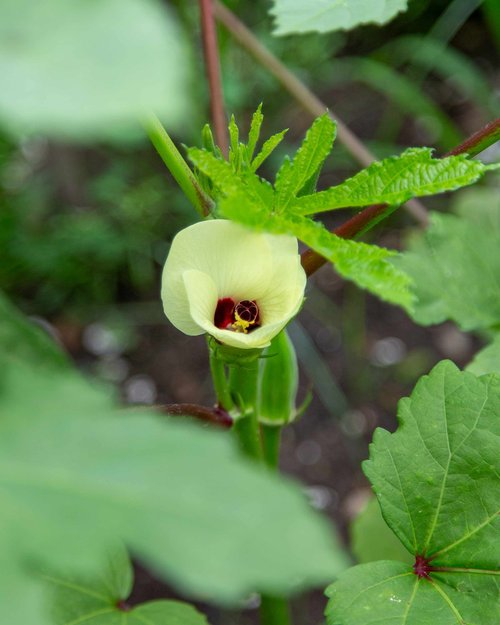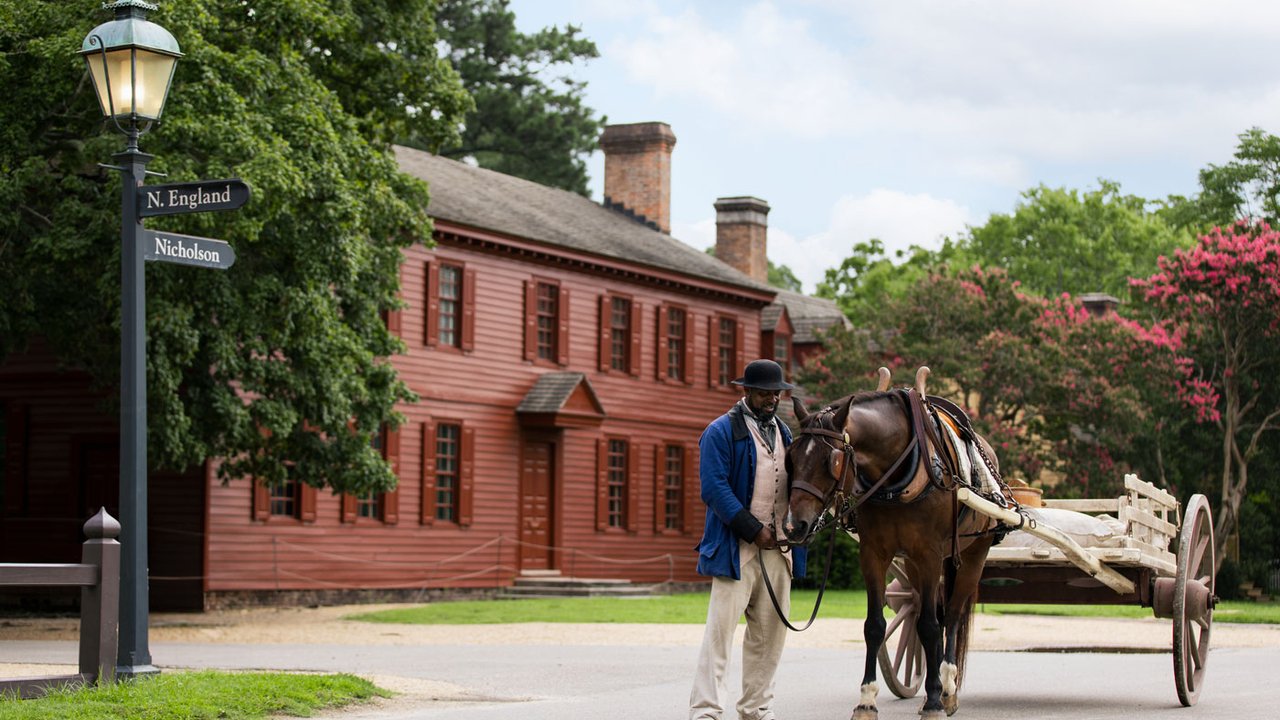
Gardening by Moonlight: Enslaved Peoples’ Plantation Gardens in Virginia
Aching from a full day of heavy plantation labor, many enslaved people in eighteenth-century Virginia dragged their hoes back to their quarters. As darkness came, they began another shift of planting, tending, and harvesting crops. The moon would sometimes provide light. They might also use torches. Only on Sundays, a weekly day of respite, could they garden in the light of day.1
Enslaved people on eighteenth-century Virginia plantations grew much of their food in garden plots. Though some enslaved people also likely gardened in urban centers like Williamsburg, there is less evidence to support this.2
Why Did Enslaved People Garden?
Virginia’s enslavers provided only meager allowances of food to enslaved people. Gardens were necessary to provide the food and energy that enslaved people needed to sustain themselves through the punishing physical labor demanded of them. Older enslaved people, who could not labor in the fields, likely kept the most extensive gardens. They not only had more time to devote to plant cultivation, but also more need for supplemental foods. Once an enslaved person was too old for work assignments, enslavers usually slashed their rations.3

Evidence indicates that enslaved people grew vegetables like collards in their own gardens.
What Were Enslaved Peoples’ Gardens Like?
Enslaved peoples’ garden plots generally surrounded their quarters. Visitors to Chesapeake plantations often remarked on how small these gardens were. An English visitor noted in 1746 that enslaved people “cultivate, at vacant Times, the little Spots allow’d them.”4 One visitor to George Washington’s Mount Vernon recalled “a very small garden planted with vegetables.”5 Diarist Philip Fithian witnessed enslaved people “digging up their small Lots of ground” on a Sunday, “as they are otherwise employed on every other Day.”6
Fithian saw that enslaved people had very little free time. Eighteenth-century Virginia plantations generally operated according to the “gang” system of labor, which required enslaved people to work from sunrise to sunset. In the South Carolina Lowcountry, where the “task” labor system was more common, enslaved people could finish the work assigned to them for a day and then tend to their own gardens afterward. As a result, enslaved South Carolinians often had much larger gardens.7
These small gardens were enclosed with fences. Fithian recorded watching “the Negroes make a fence; they drive into the Ground Chesnut stakes about two feet apart in a straight Row, & then twist in the Boughs of Savin [red cedar] which grows in great plenty here.”8 These fences were necessary to protect their crops, especially as enslaved people often kept chickens around their homes.9

What Crops Did Enslaved People Grow?
Enslaved peoples’ gardens were densely planted with a mix of high-yield, easy-to-grow foodstuffs. Some of the most popular were potatoes, beans, peas, collards, and melons.10 In 1732, William Hugh Grove recorded that enslaved people “plant little Platts for potatoes . . . Indian pease [peas] and Cimnells [squash], which they do on Sundays or night, for they Work from Sunrising to setting.”11 According to another observer named William Tatham in 1800, the following crops were “permitted” to enslaved people: “potatoes, garden-stuff, pumpkins, melons, a few particular fruit-trees, peas, hops, flax, and cotton.”12
Archaeological research at Virginia plantations has also uncovered evidence of barley, peanuts, rye, wheat, corn, and sunflower seeds in the quarters of enslaved people.13
Not every plant grown in enslaved peoples’ gardens was meant to be food. Some gardens would have grown medicinal herbs for healing practices. Enslaved people also sometimes grew other plants such as hops, gourds, and tobacco. But they were usually not permitted to use their garden to cultivate the same cash crop they grew for their enslaver.14 As Thomas Jefferson explained, it was necessary to limit enslaved people ”to such articles as are not raised on the farm, there is no other way of drawing a line between what is theirs & mine.”

An okra plant flowers in July.
What Did Enslaved People Do with Their Crops?
Enslaved people cooked and ate most of the food they grew in their own gardens. After harvesting garden produce, enslaved people preserved some of it in pits dug into the floors of their quarters.15
But when enslaved people produced a surplus, or a crop that was not intended for consumption, they often sold it.16 For example, Virginia Governor Lord Botetourt once purchased “44 lb. Hops” from someone whose name was recorded as “Negro Jemmy.”17 Likewise, Fithian’s diary recorded an occasion when an old, enslaved man, whom he identified as “Dadda Gumby,” offered him “Eggs, Apples, Potatoes.”18 The account books of Thomas Jefferson and his family document hundreds of food items purchased from dozens of members of the enslaved community at Monticello. The foods purchased included cucumbers, peaches, melons, squash, cabbage, potatoes, hops, walnuts, salad, sweet potatoes, sprouts, strawberries, apples, and beets.19
Enslaved people who lived in, or nearby, market towns could sell their produce in the town market. In some cases, an enslaved person might have sell their produce at the market to another enslaved person sent on behalf of a white household.20 With these earnings, enslaved people could purchase clothes, other goods, or in some cases, could even save up to purchase their freedom from an enslaver.

A torch illuminates a trellis of case knife beans at night.
Conclusion
Gardens were an important part of enslaved peoples’ lives. Their plots surrounded their quarters. Many slept with vegetables under their floors and dirt under their fingernails. While wealthy enslavers sometimes called themselves “planters,” it was enslaved people who planted the crops that sustained these plantations. Visit the Historic Gardener trade in Colonial Williamsburg’s Historic Area to learn more about how enslaved people gardened and fed themselves.
Stories of Black Life
During the 18th century, half of Williamsburg’s population was Black. Discover these American stories of resilience and explore those who lived, loved, and strove to create a better future.

Sources
Cover image: Culinary Historian Michael Twitty (right) and interpreter Robert Watson (left) recreate enslaved people working on their garden and picking vegetables by the light of torches and the full moon.
- Patricia Gibbs, “‘Little Spots allow’d them’: Slave Gardens in the Eighteenth Century,” in Proceedings of the Thirteenth Conference on Restoring Southern Gardens and Landscapes (Winston-Salem: Old Salem, 2003), 61.
- Gibbs, “‘Little Spots allow’d them,’” 12.
- Gibbs, “‘Little Spots allow’d them,’” 62.
- [Edward Kimber], “Observations in several Voyages and Travels in America, continued from Page 248,” The London Magazine: And Monthly Chronologer [1746] (London: T. Astley, 1732–1735), 324, link.
- Julian Ursyn Niemcewicz, Under Their Vine and Fig Tree: Travels Through America in 1797-1799, 1805, with Some Further Account of Life in New Jersey (Elizabeth, N.J.: Grassmann Pub. Co., 1965), 100.
- Philip Vickers Fithian, Journal and Letters, 1767-1774: Student at Princeton College, 1770–72 Tutor at Nomini Hall in Virginia 1773–74, ed. John Rogers Williams (Princeton: Princeton Historical Association, 1900), 151, link.
- Philip D. Morgan, Slave Counterpoint: Black Culture in the Eighteenth-Century Chesapeake and Lowcountry (Chapel Hill: University of North Carolina Press for the Omohundro Institute of Early American History and Culture, 1998), 193–94.
- Fithian, Journal and Letters, 1767-1774, 120, link.
- Gibbs, “‘Little Spots allow’d them,’” 63.
- Gibbs, “‘Little Spots allow’d them,’” 61.
- William Hugh Grove, “Virginia in 1732: The Travel Journal of William Hugh Grove,” Virginia Magazine of History and Biography 85 (no. 1, Jan. 1977): 32.
- William Tatham, Communications concerning the agriculture and commerce of the United States of America (London: J. Ridgway, 1800), 55, link; Gibbs, “‘Little Spots allow’d them,’” 60.
- Gibbs, “‘Little Spots allow’d them,’” 59–60.
- Gibbs, “‘Little Spots allow’d them,’” 61; Sharla Fett, Working Cures: Healing, Health, and Power on Southern Slave Plantations (Chapel Hill: University of North Carolina Press, 2002), 72.
- Peter J. Hatch, "A Rich Spot of Earth": Thomas Jefferson's Revolutionary Garden at Monticello (New Haven: Yale University Press, 2012), 64–65.
- Gibbs, “‘Little Spots allow’d them,’” 62–63.
- Gibbs, “‘Little Spots allow’d them,’” 67n15.
- Fithian, Journal and Letters, 1767-1774, 205, link.
- Peter J. Hatch, "A Rich Spot of Earth": Thomas Jefferson's Revolutionary Garden at Monticello (New Haven: Yale University Press, 2012), 63; Gerard W. Gawalt, “Jefferson’s Slaves: Crop Accounts at Monticello, 1805–1808,” Journal of the Afro-American Historical and Genealogical Society 13 (no. 1/2, 1994): 19–38.
- Gibbs, “‘Little Spots allow’d them,’” 64.
